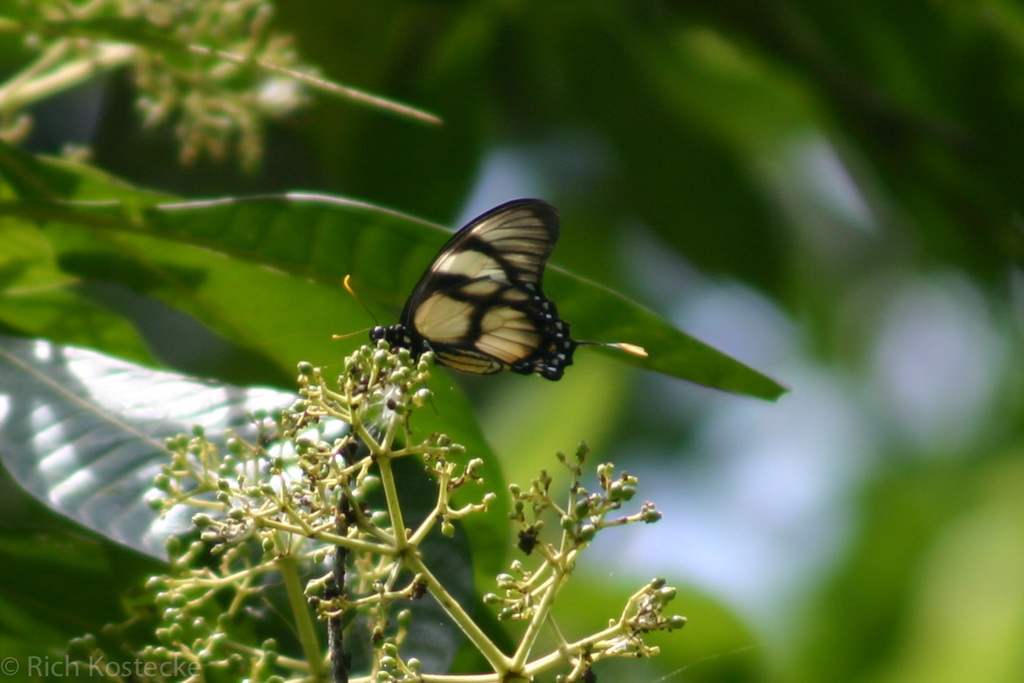This week's butterfly species is one of those whose status in the world of entomology is uncertain. It is currently recognized as a species with six subspecies, but some question whether it's really the same thing as Eurytides iphitas, perhaps a variant form influenced by weather conditions. (Some butterflies look completely different if they matured in different weather conditions; we'll soon come to Eurytides or Protographium marcellus, which, when I was in school, was believed to be three distinct species.)
Photo by Ackruger, in Brazil, in December. They occasionally fan their wings out, as shown above, to catch the sun, but more often hold their wings upright. The upright wings are hard to see from most angles, and catch less heat. When butterflies spread their wings wide they are warming themselves, a behavior often observed in the Northern States and Canada.
All subspecies of dolicaon have rhat bent bar of dark color across the leading edge of the forewings. The rest of the pattern differs slightly among subspecies. Photos of all subspecies were not available, but here is Eurytides dolicaon deicoon:
Photo by Karsten Schoenherr, September, Peru.
Museum specimens from Butterflies Of America: E.d. septentrionalis:
No positively identified photo of E.d. cauraensis or cauras has been posted online. It should be noted that color is not a reliable guide to subspecies. Some individuals are more faded than others. The generalization that males are more vividly colored than females is not made about this species. (In the few specimens he studied, Rothschild found the females to be just noticeably larger than the males. Other authors don't mention this. The best way to tell the sex of a butterfly is to see whether it lays eggs, and so far that seems not to have been done with regard to dolicaon.)The predominant color for all butterflies in this species is thought to be a creamy white that can look yellow, in some individuals, in some lights, or green, in others.
This butterfly is found in rainforests, at altitudes up to 1300 feet above sea level.
Eurytides dolicaon was named early enough (in 1775) to be named for a character in ancient literature, a minor character in Vergil whose name is usually spelled with an H (Dolichaon). It has no really common name in English since it's not found in English-speaking countries, but it is sometimes called Dolicaon and sometimes the Thin-Tailed Kite.
In Pedromariposa's charming, slow-motion video you can make out dolicaon's distinctive wing markings on one of the butterflies flitting in and out of the mixed group shown...or just watch the flock "puddling," as a way to relax.
Not altogether peaceable, as the butterflies are occasionally pestered by predators, but they do form a peaceful little group with one another. This is the way most Swallowtail butterflies are most often seen and, unfortunately, about the only way some of these butterflies have been documented even today. We also see how, although dolicaon and the other Kite Swallowtails are considered "large butterflies," they're not nearly so large as some of the other tropical Swallowtails. Dolicaon has a wingspan usually a little over 3 inches.
Like some other Kites, dolicaon seems to be solitary. Butterflies that have only one host plant tend to like to be the only one of their sex and species in a neighborhood. However, nobody seems to be positive about what dolicaon eat, or what the early forms of the butterfly look like. "According to Hancock the larva is smooth," and can eat leaves from some plants in the families Annonaceae and Lauraceae--but nobody else seems to have confirmed this. There is thought to be one generation in a month between August and April, with individuls that pupate in April "overwintering" and eclosing as adult butterflies in August. There is still time for people who want to make contributions to science to try rearing these butterflies, or watching them grow up, and find out whether Hancock was correct.
In fact, scientists aren't even positive about what the females look like--whether the two butterflies above are a couple, e.g. If their behavior pattern is like our Zebra Swallowtails', they don't seem to humans to have an odor, but they can smell one another--and look for places where they can't smell one another. Females want to be the only females laying eggs on the trees where they lay their eggs, and males want to be their potential mates' first and thus only partners. In that case the two sipping water together, or the pair photographed sticking together in a multi-photo sequence at INaturalist, would be courting couples; but nobody knows for sure. Lubomir Klatil thinks it may be typical for females to have wider dark borders on each wing than males have; it remains for others to confirm to what extent this is true.
Photo by Rkostecke, in Panama, in June. Do both sexes pollinate? Do males compost? Nobody seems certain. This individual is pollinating.
It is sparse but not terribly rare. Photos show one or two, not three, dolicaon in a group with several other species. It's popular; Franco Giuseppe Rodolfo Po even composed a tune for it in 2022:
And many of the links for this species on the Internet show that it has inspired arts and crafts pieces. But the South American Kites have yet to be the focus of much scientific study.








No comments:
Post a Comment